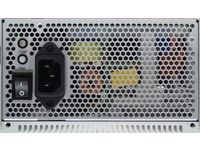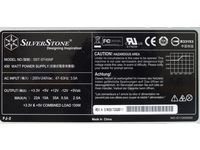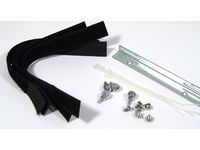Silent PSUs: Fortron Versus Silverstone
Silverstone Nightjar 450 (Continued)
On the rear of the power supply there is an IEC socket and an non-illuminated main switch, as well as two LEDs that indicate the operational status of the power supply.

Whereas the top LED shows the temperatures—at over 55°C the usually green LED switches to yellow—the lower LED tells you whether the unit is in standby (orange), switched on (green) or cannot be switched on due to a fault (red). The latter occurs, for example, when the power supply has overheated and deactivated itself.
Unlike the Fortron Zen, the Silverstone unit is silent—even under the highest load—and does not make any whirring noises.

If the unit is placed under a load of 450 watts without ventilation, it switches itself off automatically after about two hours due to overheating, but at an output of 330 watts, we were able to operate it constantly. As with the Fortron unit, a very low flow of air is sufficient to enable constant operation even under a full load of 450 watts.

The Silverstone Nightjar was also able to operate our D201GLY2 board from Intel with no trouble at all.
Stay on the Cutting Edge
Join the experts who read Tom's Hardware for the inside track on enthusiast PC tech news — and have for over 25 years. We'll send breaking news and in-depth reviews of CPUs, GPUs, AI, maker hardware and more straight to your inbox.
Current page: Silverstone Nightjar 450 (Continued)
Prev Page Silverstone Nightjar 450 Next Page Voltages-
knowom I think they'd be great for a digital audio workstation environment now if only there was some more competition in this market segment to drive prices down to a more decent level.Reply -
mdmadph "The +12V CPU connection is only available as 4-pin version, which can lead to problems with some boards that require an 8-pin connection."Reply
Know of many HTPC boards that need an 8-pin CPU connection? :\ I sure don't. -
I have read 3-4 other reviews of the zen 400W, and I'm pretty sure there has been no mention of the high pitched sound. It's not a good sign for the zen, but it's probably a faulty powersupply tested in this review.Reply
-
gwolfman Ummmm, so where's the temps? The review is practically pointless without temp measurements on a fanless PSU. BOOOOO!Reply -
jeffunit Without specifying the input voltage, efficiency measurements are pretty useless. Running at 240v will yield a few percent higher efficiency than 120. Even 240v will be more efficient than 220v.Reply -
kittle Re-run your review and include tempratures. Its pointless w/o them.Reply
If you have found a fanless PSU thats safe to touch -- thats great. but if these things get to 40, 50, 60c - then we need to know not to buy them. -
I own the Zen400 power supply and it's exactly what I needed for a quiet HTPC, to the point where it's literally impossible to tell when the PC is on. During normal operation I have never heard the high pitched sound this review mentions (although it did output a sound similar in volume and annoyance to a smoke alarm when I failed to plug in the power cable to the graphics card - it was clearly an error/failure tone).Reply
-
In regards to the lack of the 8 pin CPU 12v connector, if you can find a motherboard of which the 4 +12v pins of the port are not electrically connected, please point it out to actually justify needing the 8 pin connector. To be honest, a motherboard with a single +12v pin isolated to only 1 or 2 vcore phases would'nt be any motherboard you would want to purchase, for power efficiency reasons.Reply
-
Alternator I agree with the above posters, temps would be nice, and not just of the PSU...Reply
I am quite interested in getting a capable (above 400watt) PSU that doesn't require a fan, but I really need to keep an eye on the temperatures.
I have a fanless mb and vid card (3850 radeon), and would wonder if adding a fanless psu into the mix would jeopardise the system by reducing the air flow through the case. (after all I wouldn't get a fanless PSU if my other components were noisy to begin with!?)
Perhaps an article focused more on configuring a quiet computer (for the purpose of gaming) could be in order?
Most Popular

